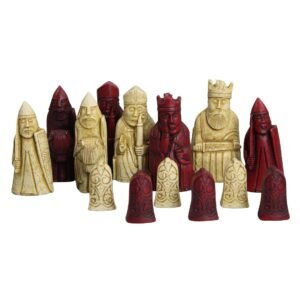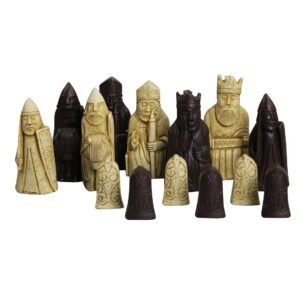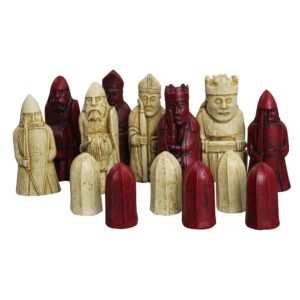




The game of chess, often regarded as the ultimate battle of intellect and strategy, has been played and admired across cultures for over a millennium. Among the most intriguing and historically significant chess sets in existence are the Isle of Lewis Chess Pieces. These ancient artefacts, carved with remarkable intricacy and loaded with symbolic meaning, continue to captivate historians, art enthusiasts, and chess players alike.
Discovered in 1831 on the Isle of Lewis, located in Scotland’s Outer Hebrides, these medieval chess pieces have fascinated scholars with their mysterious origins and extraordinary craftsmanship. Their enigmatic history, combined with their connection to both Norse and Scottish heritage, makes them more than mere game pieces—they are cultural treasures that offer a glimpse into the medieval world. This article delves into the rich history, craftsmanship, symbolism, and lasting cultural impact of the Isle of Lewis Chess Pieces, shedding light on why they remain one of the most iconic chess sets in history.
The discovery of the Isle of Lewis Chessmen was nothing short of serendipitous. In 1831, a hoard of 93 chess pieces, along with some other artefacts, was uncovered from a sandbank near Uig on the Isle of Lewis. The find immediately captured public attention due to the sheer beauty and mysterious nature of the artefacts. Thought to date back to the late 12th or early 13th century, these pieces are considered some of the finest examples of medieval European chess craftsmanship.
The prevailing theory suggests that the chessmen were likely crafted in Norway, during a time when the Outer Hebrides were under Norse control. This period was marked by significant Viking influence across Scotland’s western isles, making it plausible that the pieces were either crafted by Norse artisans or brought to the region by Norse settlers or traders.
The reasons behind their burial on the Isle of Lewis remain a subject of speculation. Some historians believe they were hidden by a merchant fearful of theft during transit, while others suggest they may have been buried intentionally as part of a forgotten ritual or as a safeguard during turbulent times. Regardless of the reason, their rediscovery centuries later has provided scholars with invaluable insight into medieval Norse society and its connection with Scotland.
One of the most striking aspects of the Isle of Lewis Chessmen is their exquisite craftsmanship. The majority of the pieces were carved from walrus ivory, with some made from whale teeth. The use of these materials, both luxurious and rare, suggests that these chess pieces were intended for the elite—perhaps nobility or wealthy merchants.
The level of detail in each carving is remarkable, with artisans employing intricate carving techniques that highlight the influence of medieval Norse artistic traditions. The carvings reveal a deep understanding of human expression, with exaggerated features that convey emotion and character. The craftsmanship reflects a fusion of practicality and artistic excellence, transforming what could have been mere game pieces into elaborate works of art.
The use of ivory was particularly significant during this period, symbolising wealth and status. Artisans would have required considerable skill to work with such a challenging material, carefully carving intricate details while ensuring structural integrity. The durability of the ivory has contributed to the pieces’ preservation, allowing modern audiences to appreciate the incredible skill and dedication of their creators.
The Isle of Lewis Chess Pieces are renowned not just for their historical value but also for their unique and expressive design. Each piece exudes a character that transcends its functional role in the game of chess, embodying the social and cultural elements of medieval life.
The kings are depicted as regal figures seated on thrones, clutching swords as symbols of authority and power. Their solemn expressions convey a sense of responsibility and command, reflective of the leadership roles they represent.
The queens are particularly notable for their distinctive portrayal—seated figures with one hand on their cheek, a gesture that has been interpreted as a sign of contemplation or worry. This depiction of the queen adds a human dimension, suggesting the burdens of power and decision-making.
The bishops reflect the church’s influence during medieval times. They are shown holding croziers, symbols of religious authority, and are dressed in elaborate robes that reflect their ecclesiastical status. Their inclusion highlights the significant role that religion played in medieval society.
The knights are portrayed on horseback, clad in chainmail and carrying shields. Their design reflects the military traditions of the Norse world, symbolising courage and martial prowess.
The rooks (often referred to as warders in this set) take on an unusually fierce appearance, represented as standing warriors armed with shields and swords. Their aggressive posture and grim expressions suggest readiness for battle, offering a glimpse into the martial culture of the time.
The pawns, though simpler in design, are still distinctively carved. They are depicted as standing stones or simple figures, representing the common foot soldiers of medieval society—humble but essential.
The Isle of Lewis Chessmen hold immense cultural significance, not only as game pieces but also as reflections of medieval society and its power structures. Their design offers insight into the social hierarchy of the time, with clear depictions of monarchy, religious authority, and military might.
These pieces also highlight the deep cultural ties between Scotland and Norway during the medieval period. The influence of Viking craftsmanship and design is evident in the detailed carvings and artistic motifs, bridging the cultural histories of both nations. The chessmen are a testament to the interconnectedness of medieval Europe, where trade, conquest, and migration facilitated the exchange of ideas and artistic traditions.
Beyond historical scholarship, the chessmen have influenced modern perceptions of medieval art and craftsmanship. Their expressive features and intricate designs challenge the notion of the so-called Dark Ages as a time devoid of artistic achievement. Instead, they highlight the sophistication and cultural richness of medieval society.
Today, the Isle of Lewis Chessmen continue to inspire artists, designers, and chess enthusiasts around the world. Modern replicas of the original pieces are widely available, offering both functional game sets and decorative art objects. Many of these replicas are crafted from resin, designed to mimic the look and feel of the original ivory pieces while making them accessible to a broader audience.
These chessmen have also made their mark in popular culture. Perhaps most famously, a replica set appeared in the 2001 film Harry Potter and the Philosopher’s Stone, introducing the chessmen to a global audience and sparking renewed interest in their unique design.
In addition to film appearances, the Isle of Lewis Chess Pieces have been featured in exhibitions and museums around the world. Their iconic status has turned them into symbols of both Scottish heritage and medieval craftsmanship, celebrated by historians, artists, and collectors alike.
The original Isle of Lewis Chess Pieces are divided between two institutions: the British Museum in London and the National Museum of Scotland in Edinburgh. The majority of the pieces—82 in total—are housed in the British Museum, while 11 pieces remain in the National Museum of Scotland.
The division of the chessmen has been a topic of ongoing debate, with calls for the full set to be returned to Scotland, where they were originally discovered. Advocates for repatriation argue that the pieces are a vital part of Scottish cultural heritage and should be reunited within their historical context.
Despite these debates, both institutions continue to display the chessmen prominently, offering visitors the opportunity to appreciate their beauty and historical significance. In recent years, the chessmen have also been featured in international exhibitions, allowing a global audience to witness these remarkable artefacts firsthand.
The enduring legacy of the Isle of Lewis Chess Pieces lies in their ability to transcend time and remain relevant across centuries. They are not merely relics of a distant past but living symbols of cultural exchange, artistic innovation, and intellectual pursuit.
For historians, the chessmen offer valuable insight into medieval society, reflecting themes of power, religion, and warfare that were central to life in 12th-century Europe. For artists and craftsmen, they serve as a source of inspiration, showcasing the enduring beauty of detailed, expressive sculpture. And for chess enthusiasts, they embody the timeless nature of the game itself—a pursuit of strategy and intellect that has captivated humanity for over a thousand years.
The continued fascination with the Isle of Lewis Chess Pieces is a testament to their historical, artistic, and cultural significance. They remain objects of wonder and scholarly interest, bridging the ancient and modern worlds through their enduring appeal.
The Isle of Lewis Chess Pieces stand as a testament to the ingenuity and artistic brilliance of medieval artisans. From their mysterious origins to their intricate craftsmanship, these remarkable artefacts continue to inspire awe and admiration. They are more than mere game pieces—they are historical treasures that offer insight into a rich and complex past.
Today, their legacy lives on through museum exhibitions, modern replicas, and popular culture, ensuring that their story continues to captivate new generations. Whether appreciated for their historical value, artistic merit, or cultural significance, the Isle of Lewis Chess Pieces remain a symbol of the enduring beauty and complexity of human creativity.